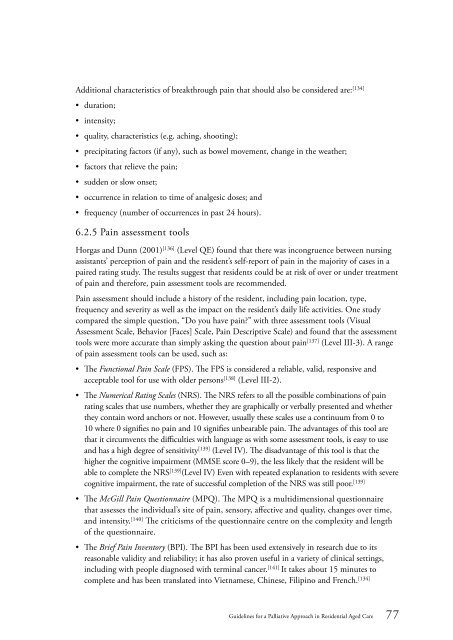Guidelines for a Palliative Approach in Residential Aged Care
Guidelines for a Palliative Approach in Residential Aged Care
Guidelines for a Palliative Approach in Residential Aged Care
You also want an ePaper? Increase the reach of your titles
YUMPU automatically turns print PDFs into web optimized ePapers that Google loves.
Additional characteristics of breakthrough pa<strong>in</strong> that should also be considered are: [134]<br />
• duration;<br />
• <strong>in</strong>tensity;<br />
• quality, characteristics (e.g. ach<strong>in</strong>g, shoot<strong>in</strong>g);<br />
• precipitat<strong>in</strong>g factors (if any), such as bowel movement, change <strong>in</strong> the weather;<br />
• factors that relieve the pa<strong>in</strong>;<br />
• sudden or slow onset;<br />
• occurrence <strong>in</strong> relation to time of analgesic doses; and<br />
• frequency (number of occurrences <strong>in</strong> past 24 hours).<br />
6.2.5 Pa<strong>in</strong> assessment tools<br />
Horgas and Dunn (2001) [136] (Level QE) found that there was <strong>in</strong>congruence between nurs<strong>in</strong>g<br />
assistants’ perception of pa<strong>in</strong> and the resident’s self-report of pa<strong>in</strong> <strong>in</strong> the majority of cases <strong>in</strong> a<br />
paired rat<strong>in</strong>g study. The results suggest that residents could be at risk of over or under treatment<br />
of pa<strong>in</strong> and there<strong>for</strong>e, pa<strong>in</strong> assessment tools are recommended.<br />
Pa<strong>in</strong> assessment should <strong>in</strong>clude a history of the resident, <strong>in</strong>clud<strong>in</strong>g pa<strong>in</strong> location, type,<br />
frequency and severity as well as the impact on the resident’s daily life activities. One study<br />
compared the simple question, “Do you have pa<strong>in</strong>?” with three assessment tools (Visual<br />
Assessment Scale, Behavior [Faces] Scale, Pa<strong>in</strong> Descriptive Scale) and found that the assessment<br />
tools were more accurate than simply ask<strong>in</strong>g the question about pa<strong>in</strong> [137] (Level III-3). A range<br />
of pa<strong>in</strong> assessment tools can be used, such as:<br />
• The Functional Pa<strong>in</strong> Scale (FPS). The FPS is considered a reliable, valid, responsive and<br />
acceptable tool <strong>for</strong> use with older persons [138] (Level III-2).<br />
• The Numerical Rat<strong>in</strong>g Scales (NRS). The NRS refers to all the possible comb<strong>in</strong>ations of pa<strong>in</strong><br />
rat<strong>in</strong>g scales that use numbers, whether they are graphically or verbally presented and whether<br />
they conta<strong>in</strong> word anchors or not. However, usually these scales use a cont<strong>in</strong>uum from 0 to<br />
10 where 0 signifies no pa<strong>in</strong> and 10 signifies unbearable pa<strong>in</strong>. The advantages of this tool are<br />
that it circumvents the difficulties with language as with some assessment tools, is easy to use<br />
and has a high degree of sensitivity [139] (Level IV). The disadvantage of this tool is that the<br />
higher the cognitive impairment (MMSE score 0–9), the less likely that the resident will be<br />
able to complete the NRS [139] (Level IV) Even with repeated explanation to residents with severe<br />
cognitive impairment, the rate of successful completion of the NRS was still poor. [139]<br />
• The McGill Pa<strong>in</strong> Questionnaire (MPQ). The MPQ is a multidimensional questionnaire<br />
that assesses the <strong>in</strong>dividual’s site of pa<strong>in</strong>, sensory, affective and quality, changes over time,<br />
and <strong>in</strong>tensity. [140] The criticisms of the questionnaire centre on the complexity and length<br />
of the questionnaire.<br />
• The Brief Pa<strong>in</strong> Inventory (BPI). The BPI has been used extensively <strong>in</strong> research due to its<br />
reasonable validity and reliability; it has also proven useful <strong>in</strong> a variety of cl<strong>in</strong>ical sett<strong>in</strong>gs,<br />
<strong>in</strong>clud<strong>in</strong>g with people diagnosed with term<strong>in</strong>al cancer. [141] It takes about 15 m<strong>in</strong>utes to<br />
complete and has been translated <strong>in</strong>to Vietnamese, Ch<strong>in</strong>ese, Filip<strong>in</strong>o and French. [134]<br />
<strong>Guidel<strong>in</strong>es</strong> <strong>for</strong> a <strong>Palliative</strong> <strong>Approach</strong> <strong>in</strong> <strong>Residential</strong> <strong>Aged</strong> <strong>Care</strong> 77
















